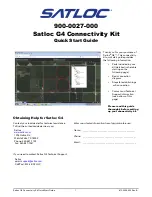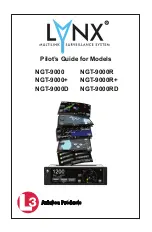
9
190-00607-02 Rev C
Detailed Operation
ADS-B Traffic
A small up or down arrow next to the identifier
indicates that the traffic is climbing or descending
at a rate of at least 500 feet per minute. The end of
the vector line that extends beyond the point of the
traffic arrow indicates where it will be at the end of
the selected time interval. The currently selected time
interval is indicated in the upper left corner of the
display.
Selected ADS-B Target Information Detail
TIS-B Traffic
Traffic Information Service – Broadcast (TIS-B) is
supported by displaying non ADS-B equipped aircraft
that are received over the UAT data link radio. Non
ADS-B equipped aircraft that are detected by ground-
based radar can be up-linked to all aircraft in the area
that are UAT data link equipped and within the GBT
service volume.
As TIS target location is determined by ground
based radar, coverage, range and target positional
accuracy are highly dependent on relative location to
the actual radar site.
Traffic Information Services-Broadcast (TIS-B) is
the broadcast of traffic information to ADS-B equipped
aircraft from ADS-B ground stations. The source of
this traffic information is derived from ground-based
air traffic surveillance sensors, typically radar. TIS-B
is intended to provide ADS-B equipped aircraft with
a more complete traffic picture in situations where
not all nearby aircraft are equipped with ADS-B. The
advisory-only application enhances a pilot’s visual
acquisition of other traffic. TIS-B service is becoming
available in selected locations where there are both
adequate surveillance coverage from ground sen-
sors and adequate broadcast coverage from Ground
Based Transceivers (GBTs). The quality level of traffic
information provided by TIS-B is dependent upon the
number and type of ground sensors available as TIS-B
sources and the timeliness of the reported data.
In order to receive TIS-B services, the following
conditions must exist:
1. The host arcraft must be equpped wth a UAT
ADS-B transmtter / recever or transcever. As
the ground system evolves, the ADS-B data lnk
may be ether UAT or 1090 ES, or both.
2. The host arcraft must fly wthn the coverage
volume of a compatble GBT that s configured
for TIS-B uplnks. (Not all GBTs provde TIS-B
due to a lack of radar coverage or because a
radar feed s not avalable).
. The target arcraft must be wthn the coverage
of, and detected by, at least one of the ATC
radars servng the GBT n use.
Only transponder-equipped targets (i.e., Mode A/C
or Mode S transponders) are detected. Current radar
siting may result in limited radar surveillance coverage
at lower altitudes near some general aviation airports,
with subsequently limited TIS-B Service volume cover-
age. If there is no radar coverage in a given area, then
there will be no TIS-B coverage in that area.
















































